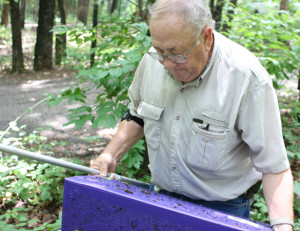The U.S. Department of Agriculture’s Animal and Plant Health Inspection Service (APHIS) this week proclaimed August as “Invasive Plant Pest and Disease Awareness Month.” According to a press release, beginning this year, APHIS will engage the public each August to increase understanding about the risks that invasive plant pests, diseases and harmful weeds pose to America’s agricultural and natural resources.
Texas has more than its share of exotic pests, and more are expected to arrive over the next few years (Reminds me of the bumper sticker, “Not a Native Texan, But I Got Here as Fast as I Could”). Unfortunately, this is rarely a good thing–think red imported fire ants.

Dr. Charlie Helpert, Texas AgriLife Extension Service, checks the purple sticky traps being used to monitor for emerald ash borer in state parks around Texas.
So I support the USDA’s exotic pest awareness month, and I hope gardeners and naturalists around the state will too. The fact that efforts are being made to raise awareness of invasive species is an indication of a growing awareness of the importance of citizens in helping spot and report problems with invasive pests.
To give a current example, for the past three summers the USDA has supported surveillance for the Emerald ash borer in Texas. This summer my lab is conducting the statewide sampling for this beetle. Dr. Charlie Helpert has traveled thousands of miles over the past several months, putting out traps and looking for signs of the small but colorful beetles that spell death to ash trees. Turns out that in the absence of its Asian natural enemies and diseases, the emerald ash borer is especially devastating to natural stands of ash here in the U.S. Even the Louisville slugger manufacturer in KY has issued dire warnings about the impact of this pest on ash bat manufacture in the country.
Some days of sampling for the beetle (none have been found so far in Texas) looking these beetles feels a lot like searching for the proverbial needle in the haystack. But if even a small fraction of the state’s gardeners and landowners and naturalists can be trained to spot and report suspicious ash tree death, we would have a much better chance of spotting and responding to early invasions of this beetle. Of course raising awareness about the importance of not shipping firewood from infested to un-infested areas is a major tool in slowing the spread of this insect as well. So the message is that all of us can play a part in stopping or slowing the spread of invasive pests.
If you are interested in knowing more, there is a relatively new website dedicated to invasive pests in Texas. It’s Texasinvasives.org, and it is dedicated to public information and training of citizen scientists to recognized and report the spread of invasive plants and animals. Whether you care about the ecological health of Texas, or treasure your childhood Louisville Slugger, you owe it to yourself to check it out.

